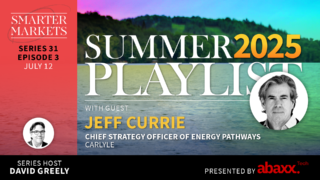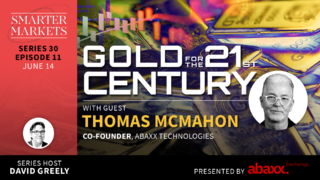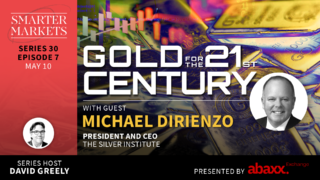We welcome Tracy Shuchart, Partner at Intelligence Quarterly and @chigrl on Twitter, into the SmarterMarkets™ studio. Host David Greely sits down with Tracy to discuss the broader impact of the European energy crisis across the commodities and financial markets.
Hosted By
Episode Q&A
The following Q&A is created using slightly edited excerpts from the episode transcript, optimized for readability. Download full transcript.
TS: We were singing secondary and tertiary effects across the entire commodity sector. Last year before the Ukraine invasion even, we saw energy prices already spiking in Europe, and people kind of forget that this started well before the Ukraine invasion. Last September, we saw spiking energy prices in the UK first, which threatened small meat firms. By October, natural gas prices got so high that started affecting fertilizer companies that were intern forced to curb production, which then caused problems in the meat packing industry because they rely on the CO2 from the fertilizer companies. And then, if we move to last fall in the EU, we saw the fertilizer industry being hit there too. We also saw iron, copper, nickel, aluminum, zinc smelters, and stainless steel mills forced to either shutter entirely or curb production because those metals are very energy intensive.
TS: We saw aluminum probably the hardest hit throughout the year, and Europe produces about 11% of global production. So since the fourth quarter of 2021, eight European countries have seen aluminum closures. We’ve had five aluminum plants in France, Romania, Slovakia, Slovenia, and Germany leading to reduced production. While we’ve had three in Spain, Netherlands, and Montenegro shut entirely, 50% of European aluminum smelting capacity is currently offline. So obviously, that’s going to lead ultimately to higher aluminum prices, higher metal prices all around because we’re facing kind of these structural supply deficits, and moving forward, we know that these countries are going to pull back on their green plants. So if we look at things like EVs that require massive amounts of aluminum, 250 kilograms per vehicle on average, solar panels, the new generation solar panels require twice the amount of aluminum that the older generation did, and obviously, turbines also require a ton of metal, ton of aluminum, a ton of steel and so this is going just to make all of these products more expensive and if metals are more expensive, manufacturing is more expensive, products more expensive. We’re going to see ripple effects across all of these sectors.
TS: It always takes a lot longer for things to play out than you initially think they do. Especially when you’re looking at big macro ideas, they take a long time, and our three major themes have been energy, metals, and agriculture. If you start with the energy sector, you know that the energy is pretty much at the heart of everything. Obviously, that started with the energy sector after the bottom fell out of the market in 2020, oil went negative, and the whole world shut down, but even before that happened, we were already seeing some supply problems in the energy sector that just derailed it for six months or so.
TS: Energy makes everything run. I knew that this would eventually affect things that were very energy intensive, like metals and particularly in the agriculture industry, which also is very energy intensive. Not only do they require fertilizer, which requires a lot of gas, but getting their farms running requires a lot of diesel, kerosene, and different fuels of that nature. Energy is at the heart of everything; then it’s kind of seeing how long it is going to take to hit these other markets, so that’s kind of the timing issue. It’s not always easy to get right, but I think that’s what we’re seeing right now.
TS: We saw a fertilizer kind of spike this summer, and I have pulled back since then, but those markets are starting to jump again because of all the production that’s being taken offline in the EU. We’re already experiencing some shortages in the US, and we’re not even at planting season yet. So looking at those markets, I think that’s going to play an even larger role in H1 of 2023 as we go into planting season. Energy input costs are going to be higher. Obviously, we’ve seen energy pull way back, but still $80, $85 that’s very high for the norm.
TS: I think we’ll see higher energy prices for longer. We’re going to see input costs for agriculture starting to storm. That will also affect supply problems, because countries like Canada and the Netherlands want to cut back on fertilizer usage, whether or not that puts some farmers out of business, which then takes more food supply off the market. The Netherlands is the number two global exporter in the world of food, and they’re looking at many farmers that could be hurt by this and go out of business. I think we barely scratch the surface. Food prices have escalated up 13% this year. Probably even higher. So, I think that’s going to be higher for longer, and I think we probably haven’t even started to scratch the surface of that yet.
TS: There’s often a prevailing notion that commodity prices are directly inversely correlated to the dollar, so people are looking for icommodity prices to go down f the dollar goes up. Certainly, there are cases that happen, and there are points in time that happen, but if you look over a long enough period, this is not the case for the most part, especially when looking at supply-side problems. Over the last two years, energy, grain prices, and industrial metals have been rising alongside the USD. So when we have these structural supply deficits in all of these markets with inelastic demand, other than shutting down the entire global economy as we did. We will continue to see rising commodity prices in the face of a rising dollar.
TS: It’s going to be a problem for the US, but it will be an even bigger problem for emerging markets. I think we’re going to see a lot more food protectionism and energy protectionism start coming into play, just as recently as India put a 25% export tax on their rice. Earlier this year, they even stopped exports altogether for the time being. I think we will see these kinds of actions coming up more and more globally.
TS: I think I have to go back to the point that pretty much everything revolves around energy. It literally runs the global economy. I think it’s particularly important for anybody to watch this sector as it affects the cost of everything else. For most businesses, energy is one of the highest input costs from small to large businesses. This factors into their bottom line and affects how they conduct business. Earlier, we talked about the ripple effects of high natural gas prices affecting smelters that in turn affects manufacturing, which in turn affects global supply chains, which in turn affects all aspects of business, from transportation to food processing to utilities to consumer discretionary to healthcare, even to the tech industry. Expanding on this supply chain problem was right after the pandemic, we saw how supply chains could be interrupted and how they could affect businesses.
TS: And even many businesses and industries continue to operate with these disruptions today. If we take, for example, the oil industry, we’re still having problems sourcing steel pipe and things of that nature. And that’s not the only business that’s still having problem kind of sourcing materials. So if we look at that and take that as a whole and know that all of these things affect whatever business you’re looking at and investing in, then you have to consider how the commodity sector factors into how they do business. I think the energy sector might be biased, but I think the energy sector should be of particular interest to anyone investing globally in any equity market.
TS: We have to realize that the source of the problem, and the energy crisis spike over the last year or so, is poor policy decisions that started a decade ago and, in some cases, two decades ago, and this has all just finally come to fruition because we had the right elements in place to spark it off. It was going to happen regardless of COVID and the Ukraine invasion – all these happening is just further exacerbated problems, but as far as policymakers need to look up, they need to understand that energy transition just doesn’t happen overnight and the technology is just not there yet.
TS: You can’t base energy policy on hope. You’re talking about the livelihood of billions of people, and I think their big mistake was wanting to switch off fossil fuels right away and switch to wind and solar power. But wind and solar are intermittent power sources, and the battery tech is just not there yet. We still need fossil fuels as our base load power, and if you don’t want, this is where natural gas is perfect for the transition fuel because it’s much cleaner than oil or coal. I’ve been talking about this for years, but they continue demonizing the industry. On the flip side, we have the option of nuclear power, which is super clean, and the most energy dense, right?
TS: You need a tiny amount of uranium to create enough energy, but the west has largely shied away from that. We haven’t done anything in the last two decades. There haven’t been a lot of upgrades; there haven’t been a lot of builds in the west. We have seen some in Africa and Asia, but we haven’t in the west because we had Chernobyl and Fukushima. The west got freaked out and marked it as dangerous. And then we had the environmental groups talking about the radioactive waste, and we’re all going to die. I think there was just not a lot of education out there. Ever since those accidents happened, there have been fantastic strides in nuclear energy.
TS: It’s very different now; it’s not the same plant that it was 20, 30 years ago. I think that’s sort of the media’s and the government’s fault for how they portrayed this without educating people. And now they’re forced to go back to the drawing table on nuclear. We’ve seen the UK wants to start eight new nuclear reactors; we see Germany deciding on and off whether to keep these last three nuclear plants. There is more interest. In the US, we just had California, for example, which wanted to shut its last nuclear plant, but now they want to keep it open for another 10 years. So we’re seeing some warming up to it.
TS: So I think that’s good as far as policymakers are looking; let’s give them a little pat on the back. It is good that we see policymakers change their view on this kind of energy, and that’s the developed market side. If we look at the emerging market side, I think the west needs to stop interfering. For example, last week, we had Simon Zarchary in Africa speaking about not investing in natural gas long-term. For developing markets, this is just really unrealistic. Cheap, abundant natural gas is a great transition fuel; although it’s not so cheap at the moment, if they were to drill locally, it would be cheap. We have to realize that over 600 million people, 43% of Africa’s population lack access to electricity.
TS: Most of them are in Sub-Saharan Africa, which has a lot of resources they could tap into. Many African countries have in trying to argue against the west and say this is unfair that you’re trying to put us in a position, and we’re just not at the same level as a DM market. I think policymakers should continue to try to get investments for their oil and gas industry to bring them out of poverty. And the west, if they want to help them, should stay out of their way a little bit and not get so involved in energy policy.
TS: Every four to eight years, you change administrations in the US. I think you should hire people with more experience than we currently have because all these energy decisions that people are making are really from people not that qualified to make those sorts of policy decisions. They are all politically motivated policies because a bunch of bureaucrats got together and decided we’re going to have this climate Paris accord, but nobody is well versed enough to say how we will get here? Everybody wants clean energy and clean air, but how are we going to get there? Governments need to have a bigger conversation with those who have more experience, not just bureaucratic think tanks.
TS: And the scary thing is it’s being so demonized, they are having a hard time finding labor in those markets; those fields are dying. If you go to college these days, nobody wants to major in the oil or mining industry because it’s dirty. It’s got bad connotations, so the labor pool is also dying. We need more engineers in those fields and get them together; this is not going to fix itself by itself. As you can see, it’s self-destructing before our eyes. So we need a whole redress of the situation, hopefully, sooner than later.
TS: Well, I had just moved to Chicago. I didn’t know anybody, and I had just started in the industry at CBOT, had a grunt job, and thought it would be a good way because I had a friend that was like, you should go one. There’s a lot of financial people on there, and I was like, okay, and so I kind of just went on to shy, Chigrl cause I wanted to be anonymous. I didn’t have my name on there for years, and so that’s how I just really started. I started talking to financial people, and my circle grew. I remember when I got like a hundred people following me, I couldn’t believe a hundred people wanted to hear what I had to say.
TS: And it grew organically. Social media can be beneficial for beneficial for everybody. But at the same time it can be very toxic. Financial Twitter, it’s a really good place where you can meet people, there’s a lot of good to be found there. There’s a lot of good advice. There’s a lot of ton of good information. There are a lot of people that you can learn from. For instance, I specialize in commodity markets. I don’t know that much about a bond market, so I can follow a bunch of bond people and learn all about bonds. I can follow a bunch of people who specializing in healthcare. I can find out about all the healthcare companies, anybody can do that. So that’s where I think that it’s beneficial because you can learn a lot from everybody else. You just have to sidestep the toxic people. There are always wil be those who would want to start fights and the best engagement with those people is no engagement.
TS: You get views from all different companies, all different kinds of traders, there’s a ton of information out there just if you’re new to Twitter, just wade through it, it’s worth it in the end.
TS: I think it was more gradual over time. It took a long time to get to like 50,000 or something, and then it kind of just grew from there. I’ve been on Twitter since like 2009. I started in the industry a little bit before then that’s a lot of dedication on.
TS: I think the sector is just starting to see the explosion of problems. The problems that have been created are not going to be fixe any time soon. I think this is going to be a strong sector for the rest of decade. It took us long to get into this mess and it’s going to take us twice as long to get out of the mess. On a shorter term, I’m kind of looking at agriculture in 2023, and I think metals will hit probably half of 2023 into 2024. As soon as some of this energy sector calms down a little bit, metals will be the next freak out. I think this sector’s strong and there are plenty of opportunities to be had out the current situation even though the situation is not great.
TS: It’s going to take at least a year for Europe to figure out its energy flow. After they do that, that’s going to exacerbate the metal problem even more. Because right now their focus is on how do we get close here. How do we get LNG here. How do we get oil and gas if we embargo Russia in December. They say they need two to three years to build LNG space, but that’s going to take a lot longer than they think. Anyway, their primary focus right now is on how to get energy flows to them to replace the flows that are not Russia related or that are Russia related.
TS: I think the metals are going to take a little bit more for that when they shift their policy back around to focusing on EVs and getting their manufacturing back up. Because right now their manufacturing shutting down. They are getting their energy house in order flow-wise. The metals going to be the next problem because they’re going to have, because of the green policy goals. So that’s why I think that’s going to take a little bit longer. I think you’re going to find huge opportunities in agriculture. I think the next surge you’re going to see is in 2023 where we’ll have spring and summer planting and there is not going to have enough fertilizer. All three sectors are going to play a huge role over this next decade.
TS: I’m focusing on energy flows right now because I think that’s the most important thing that we need to look at. Germany just came out and announce they have enough gas, at 90%, but that’ll last us through winter, which I’ve been saying all summer it’s all about flows. So right now, we should be focusing on global energy flows no matter what. I think Russian barrels are going to stay on the market more so than anybody thinks. That’s just what is going to happen because other countries are going to take advantage of that discount regardless. I would be focusing on how that energy flow space is revolving if you to use as a gauge on how quickly we can get out of this mess.







